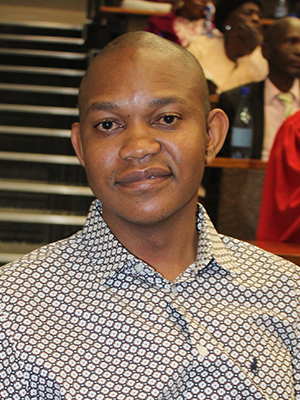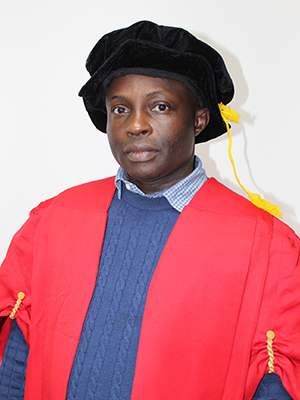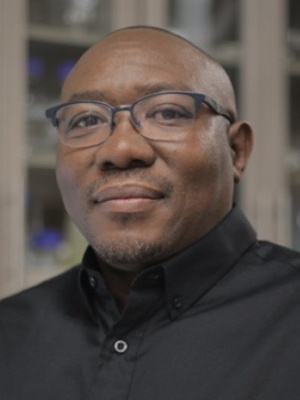
Prof Caven Mnisi
Multipronged nutritional strategies for sustainable animal production and food security...read more
Prof Caven Mnisi
Multipronged nutritional strategies for sustainable animal production and food security
Prof Mnisi’s research focuses on developing sustainable multi-tiered nutritional strategies to enhance productivity, health and environmental resilience in ruminant and poultry production systems. These strategies are designed to reduce feed costs by using locally available, underexploited plant materials; enhance nutrient utilisation through feed processing and enzyme supplementation; promote animal resilience by replacing antibiotic growth promoters with plant-based nutraceuticals; and combining a wide range of phytogenics and conventional feed additives to improve animal welfare, reduce rearing stress and contribute to safer and more sustainable animal production systems.
His work not only addresses global food security challenges but also emphasises practical solutions for environmentally friendly and socio-economically viable animal agriculture systems. Through his extensive research work and numerous student mentorships, his research has made a measurable impact on animal nutrition, particularly in the advancement of quail nutrition research and feed innovation for resource-poor farmers. He underscores the role of poultry and ruminants as a community-level strategy to combat hunger and food insecurity.
These efforts align strongly with achieving food security, environmental stewardship and animal health. Overall, Prof Mnisi’s work provides holistic solutions to contemporary challenges in animal production, aligning with global efforts to ensure sustainable, secure and safe food systems.

Prof Bassey Isong
The silent sentinel: machine learning’s role in securing and ensuring reliable software systems...read more
Prof Bassey Isong
The silent sentinel: machine learning’s role in securing and ensuring reliable software systems
In today's rapidly evolving digital age, software systems have become indispensable, with their complexity and criticality increasing exponentially. Consequently, ensuring their reliability, security and overall quality is more crucial than ever to provide societal infrastructure, drive innovation and safeguard sensitive information. As the world grows increasingly dependent on interconnected technologies, the need for robust and trustworthy systems has never been greater. Traditional quality assurance (QA) methods, while valuable, often struggle to keep pace with the complexity and scale of modern software, leaving systems vulnerable to failures, security threats and performance issues.
This lecture explores how machine learning (ML) is revolutionising QA, as a “silent sentinel”, an ever-watchful guardian, offering a smarter, more proactive approach to ensuring system dependability. Through the integration of ML into modern QA processes, traditional methods are transcended, enabling systems to continuously monitor, detect vulnerabilities, predict potential failures and respond to threats in real time. By applying tools like intelligent anomaly detection, preventive maintenance and real-time threat response, ML fosters resilient, self-healing systems that enhance functionality, performance and security. It delves into the transformative potential of ML in system dependability, highlighting modern innovations and current challenges, and envisioning the future of intelligent, self-sustaining systems. Drawing on real-world case studies and emerging research, the discussion will prove how ML redefines or reshapes the assurance of reliable and secure software systems. In addition, ethical implications and responsibilities inherent in adopting such technologies are discussed.
It concludes by emphasising that, in an age of intelligent systems, ML is a vital tool in constructing software systems that meet the highest standards of quality and trust. Interdisciplinary research and collaboration are essential to bring about a more reliable and sustainable digital future.

Prof Charl Pretorius
Uncertainty, structure and change: a non-parametric perspective...read more
Prof Charl Pretorius
Uncertainty, structure and change: a non-parametric perspective
Statistical methods help us navigate uncertainty when we are faced with data, offering structure in a world filled with noise. But how reliable are these methods, and how realistic are the assumptions upon which they are built? Furthermore, can we determine when the structure we believe in begins to change? This lecture explores these questions through the lens of non-parametric statistics, an approach that deliberately limits parametric assumptions and lets the data speak for itself. As concrete examples, I present several new procedures for detecting structural change in high-dimensional panel data – a type of multivariate time-series data commonly encountered in econometrics and finance. These detection procedures are non-parametric in the sense that they are valid for a broad class of popular models used in practical applications. A key idea that will be covered is how these procedures can be adapted to be self-normalising, in other words, so that the detection rules do not depend on nuisance parameters that are notoriously difficult to estimate without strong parametric assumptions. The procedures retain their favourable properties even in the presence of weak serial and cross-sectional dependence. These procedures are also extended to online detection procedures, where data arrives sequentially and structural changes must be identified in real time. While the methods are mathematically intricate, their purpose remains straightforward: to help distinguish actual effects from coincidental ones when uncertainty exists.

Prof Oriel Thekiso
No diagnostics, no disease control...read more
Prof Oriel Thekiso
No diagnostics, no disease control
Diagnosis is the first line of disease control, followed by treatment and management and once again diagnosis to monitor the success of the treatment. The same applies to prevention strategies, where diagnosis is conducted on a large scale through epidemiological studies, then prevention measures such as vaccinations and quarantines are applied. The success of prevention strategies is further monitored using diagnostic techniques. Observation of clinical signs and symptoms for any animal or human infection serves as the first step of a diagnosis. For laboratory diagnosis, microscopy remains the mainstay of diagnostic techniques. Serological assays that detect antibodies from plasma samples are also serving as routine diagnostic techniques especially for large-scale screening. The advent of DNA technology has revolutionised diagnostics, as DNA-based diagnostic assays are more specific and highly sensitive in order to detect infectious agents in humans and animals. My diagnostic research projects have focused on the adoption of loop-mediated isothermal amplification (LAMP) and polymerase chain reaction (PCR) for the diagnosis of various pathogens. As a result, together with various collaborators, I have developed DNA-based LAMP and PCR assays targeting specific gene fragments for the diagnosis of various animal and human diseases, including trypanosomosis, theileriosis, babesiosis, toxoplasmosis, Newcastle disease, bovine tuberculosis and brucellosis.
